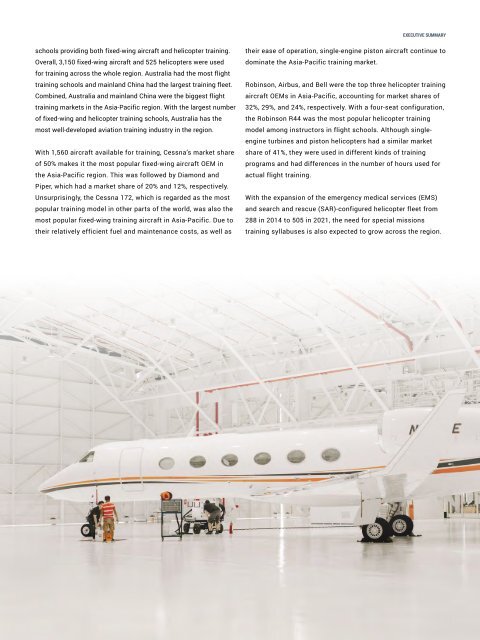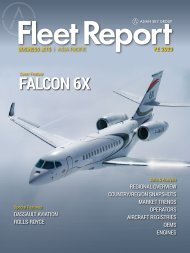Infrastructure and Training Report 2022
Create successful ePaper yourself
Turn your PDF publications into a flip-book with our unique Google optimized e-Paper software.
EXECUTIVE SUMMARY<br />
schools providing both fixed-wing aircraft <strong>and</strong> helicopter training.<br />
Overall, 3,150 fixed-wing aircraft <strong>and</strong> 525 helicopters were used<br />
for training across the whole region. Australia had the most flight<br />
training schools <strong>and</strong> mainl<strong>and</strong> China had the largest training fleet.<br />
Combined, Australia <strong>and</strong> mainl<strong>and</strong> China were the biggest flight<br />
training markets in the Asia-Pacific region. With the largest number<br />
of fixed-wing <strong>and</strong> helicopter training schools, Australia has the<br />
most well-developed aviation training industry in the region.<br />
With 1,560 aircraft available for training, Cessna’s market share<br />
of 50% makes it the most popular fixed-wing aircraft OEM in<br />
the Asia-Pacific region. This was followed by Diamond <strong>and</strong><br />
Piper, which had a market share of 20% <strong>and</strong> 12%, respectively.<br />
Unsurprisingly, the Cessna 172, which is regarded as the most<br />
popular training model in other parts of the world, was also the<br />
most popular fixed-wing training aircraft in Asia-Pacific. Due to<br />
their relatively efficient fuel <strong>and</strong> maintenance costs, as well as<br />
their ease of operation, single-engine piston aircraft continue to<br />
dominate the Asia-Pacific training market.<br />
Robinson, Airbus, <strong>and</strong> Bell were the top three helicopter training<br />
aircraft OEMs in Asia-Pacific, accounting for market shares of<br />
32%, 29%, <strong>and</strong> 24%, respectively. With a four-seat configuration,<br />
the Robinson R44 was the most popular helicopter training<br />
model among instructors in flight schools. Although singleengine<br />
turbines <strong>and</strong> piston helicopters had a similar market<br />
share of 41%, they were used in different kinds of training<br />
programs <strong>and</strong> had differences in the number of hours used for<br />
actual flight training.<br />
With the expansion of the emergency medical services (EMS)<br />
<strong>and</strong> search <strong>and</strong> rescue (SAR)-configured helicopter fleet from<br />
288 in 2014 to 505 in 2021, the need for special missions<br />
training syllabuses is also expected to grow across the region.
















